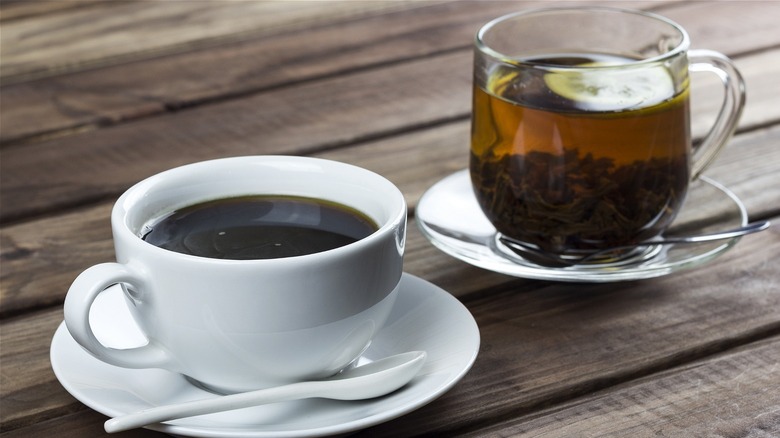How Coffee Became Even More Popular Than Tea In The UK
When the daughter of a Portuguese king married King Charles II in 1660, she started the drumbeat of tea's popularity among British aristocracy. More than a century later, a duchess got hungry waiting for the posh supper hour and asked for a cake and tea snack tray around four o'clock. The afternoon tea ritual spread and became synonymous with proper British tradition.
In only the last few months, that tradition was turned on its head by that other ubiquitous hot beverage — coffee. A recent Statista Global Consumer survey reports that 63% of the British public now prefers coffee, while 59% stick with tea. That is a change from the 2021 survey, which saw coffee tied with tea as the country's drink of choice for the first time.
What happened? Cute coffee shops and a generational shift have a lot to do with it, NBC News correspondent Molly Hunter told the Today Show. She said the Gen Z and millennial crowd love TikTok coffee tutorials and the extra hit of caffeine that coffee offers. They are edging out the "Earl Grey, English Breakfast generation," preferring flat whites and lattes. Charming coffee shops are also a reason young consumers have turned to coffee to the tune of nearly $5 billion in sales throughout Britain. Mega coffee conglomerate Starbucks, which first staked its claim on UK soil a decade ago, is projecting expansion plans for 100 new stores over the next year.
The coffee takeover started in the 70's
British tea consumption has been on a steady decline since 1974. By the 1980s, tea consumption per person had dropped 20% and was down a whopping 63% by 2014 (via The Washington Post). Industry research groups speculated at the time that the cause was an image issue young consumers had with traditional black tea, the kind consumed at proper English afternoon teas. Weigh that with the branding boost from sitcoms like "Friends" that made coffee houses cool places to linger and chill with friends. Not to mention, Starbucks launched 425 stores across the United States in 1994, and in less than a decade, it was a global brand that, by 2005, had 10,241 stores worldwide (via Bloomberg). Bougie coffee concoctions, elevated by foams, caramel swirls, and milky floating designs, won the hearts of a new generation of hot beverage consumers.
However, tea is not going down is not going down without a fight. According to tea and coffee industry news website STiR, tea brands are pivoting by rolling out new flavors like green tea and matcha. "Fresh mint tea is having a moment," Molly Hunter told her Today show colleagues. These more intense flavors may help reinvigorate interest in tea, though with sales of coffee outpacing tea, the revival may be an uphill climb.

